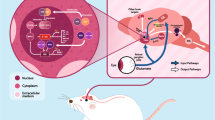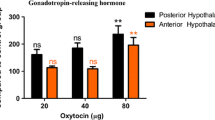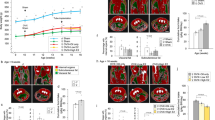Abstract
In mammals, clock-gene proteins are expressed in the neurons of hypot halamic suprachiasmatic nucleus and that of other CNS structures, in the muscles, visceral organs and vessels, thus forming circadian rhythms of many functions. Little is known about the factors of formation of the circadian mechanism at the prenatal period. In the rats, E20 stage is characterized by a high level of oxytocin and selective expression of the first protein of clock-genes PER1. The goal of present study was to check the suggestion on the positive feedback between PER1 and oxytocin at the prenatal period, as well as to elucidate a possible role of PER1 in the regulation of oxytocin and GABA interactions at the period of formation of the cerebral circadian mechanism of clockgenes. With aid of western-blotting, we analyzed the nuclear and cytoplasmic fractions of anterior hypothalamus homogenate from the pregnant females and rat embryos (E20). Retinol metabolites through their nuclear receptor RORa are known to be bound to promoters of oxytocin and per 1 genes. Next day after administration of retinol to the females, a rise in PER1 content was noted in their cytoplasm, whereas in their embryos PER1 content was elevated in the nucleus. In the embryo cytoplasm there was a significant rise in production of oxytocin receptors and a decrease in the level of enzymes of GABA synthesis (glutamate decarboxylases 67 and 65). The results indicate the oxytocin- and retinol-dependent increase in the PER1 expression and the subsequent change in the ratio of oxytocin and GABA efficiency at the prenatal stage of formation of the circadian clockmechanism in the rat embryo anterior hypothalamus.
Similar content being viewed by others
References
Turek, F.W., Circadian Clocks: Tips from the Tip of the Iceberg, Nature, 2008, vol. 456, pp. 881–883.
Grimaldi, B. and Sassone-Corsi, P., Circadian Rhythms: Metabolic Clockwork, Nature, 2007, vol. 447, pp. 386–387.
Nakahata, J., Sahar, S., Astarita, G., Kaluzova, M., and Sassone-Corsi, P., Circadian Control of the NAD+ Salvage Pathway by CLOCKSORT, Science, 2009, vol. 324, pp. 654–657.
Anisimov, V.N., Pineal Gland, Melatonin and Aging, Psikhoneiroendokrinologiya (Psycho neuro endocrinology), Shabanov, P.D. and Sapronov, N.S., Eds., St. Petersburg, 2010, pp. 740–794.
Miyazaki, M., Schroder, E., Edelmann, S.E., Hughes, M.E., Kornacker, K., Balke, C.W., and Esser, K.A., Age-Associated Disruption of Molecular Clock Expression in Skeletal Muscle of the Spontaneously Hypertensive Rat, PLos One, 2011, vol. 6, p. 27 168.
Ko, C.H. and Takahashi, J.S., Molecular Com ponents of the Mammalian Circadian Clock, Hum. Mol. Genet., 2006, vol. 15, pp. R271–R277.
El-Hennamy, R., Mateju, K., Bendova, Z., Sosniyenko, S., and Sumova, A., Maternal Control of the Fetal and Neonatal Rat Suprachiasmatic Nucleus, J. Biol. Rhythms, 2008, vol. 23, pp. 435–444.
Dickmeis, T., Glucocorticoids and the Circadian Clock, J. Endocrin., 2009, vol. 200, pp. 3–22.
De Oliveira, L.D., Camboim, C., Diehl, F., Consiglio, A.R., and Quillfeldt, A.J., Glucocorti coid-Mediated Effects of Systemic Oxytocin Upon Memory Retrieval, Neurobiol. Learn. Memory, 2007, vol. 87, pp. 67–71.
Arushanyan, E.B. and Beier, E.V., Supra chi asmatic Nuclei of Hypothalamus and Organization of Circadian Periodsm, Khronobiologiya i khronomeditsina (Chronobiology and Chronome dicine), Moscow, 2000, pp. 64–79.
Hirao, J., Arakawa, S., Watanabe, K., Ito, K., and Furukawa, T., Effects of Restricted Feeding on Daily Fluctuations of Hepatic Functions Including P450 Monooxygenase Activities in Rats, J. Biol. Chem., 2006, vol. 281, pp. 3165–3171.
Chernysheva, M.P., Spatial-Time Structure of Hormonal System in Organism, Osnovy neiroendocrinologii (Basic Neuroendocrinology), Shalyapina, V.G. and Shabanov, P.D., Eds., St. Petersburg, 2005, pp. 366–407.
Doi, M., Hirayama, J., and Sassone-Corsi, P., Circadian Regulator CLOCK is a Histone Acetyltransferase, Cell, 2006, vol. 125, pp. 497–508.
Nader, N., Chrousos, G.P., and Kino, T., Circadian Rhythm Transcription Factor CLOCK Regulates the Transcriptional Activity of the Glucocorticoid Receptor by Acetylating its Hinge Region Lysine Cluster: Potential Physiological Implications, Exp. Biol., 2009, vol. 213, pp. 841–852.
Shimizu, T., Hirai, Y., Murayama, C., Miyamoto, A., Miyazaki, H., and Miyazaki, K., Circadian Clock Genes Per2 and Clock Regulate Steroid Production, Cell Proliferation, and Luteinizing Hormone Receptor Transcription in Ovarian Granulosa Cells, BBRC, 2011, vol. 412, pp. 132–135.
Yokota, S., Yamamoto, M., Moriya, T., Akiyama, M., Fukunaga, K., Miyamoto, E., and Shibata, S., Involvement of Calcium-Calmodulin Protein Kinase but not Mitogen-Activated Protein Kinase in Light-Induced Phase Delays and Per Gene Expression in the Suprachiasmatic Nucleus of the Hamster, J. Neurochem., 2001, vol. 77, pp. 618–627.
Tischkau, S.A., Mitchell, J.W., Tiane, S.H., Buchanan, G.F., and Gillette, M.U., Ca2+/cAMP Response Element-Binding Protein (CREB)-Dependent Activation of Per1 Is Required for Light-Induced Signaling in the Suprachiasmatic Nucleus Circadian Clock, J. Biol. Chem., 2003, vol. 278, pp. 718–723.
Di Shi, Maxson, M.M., Franco, A., and Tasker, J.G., Glucocorticoids Regulate Glutamate and GABA Synapse-Specific Retrograde Trans mission via Divergent Nongenomic Signaling Pathways, J. Neurosci., 2009, vol. 29, pp. 393–401.
Gimpl, G. and Fahrenholz, F., The Oxytocin Receptor System: Structure, Function, and Regulation, Physiol. Rev., 2001, vol. 81, pp. 629–683.
Kunieda, T., Minamino, T., Miura, K., Katsuno, T., Tateno, K., Miyauchi, H., Kaneko, S., Bradfield, C.A., FitzGerald, G.A., and Komuro, I., Reduced Nitric Oxide Causes Age-Associated Impairment of Circadian Rhythmicity, Circ. Res., 2008, vol. 102, pp. 607–614.
Sato, F., Nagata, C., Liu, Y., Suzuki, T., Kondo, J., Morohashi, S., Imaizumi, T., Kato, Y., and Kijima, H., PERIOD1 Is an Anti-Apoptotic Factor in Human Pancreatic and Hepatic Cancer Cells, J. Biochem., 2009, vol. 146, pp. 833–838.
Zemkova, H.W., Bjelobaba, I., Tomic, M., Zemkova, H., and Stojilkovic, S.S., Molecular, Pharmacological and Functional Properties of GABAA Receptors in Anterior Pituitary Cells, J. Physiol., 2008, vol. 586, pp. 3097–3111.
Mikhrina, A.L., Romanova, I.V., and Chernysheva, M.P., Effect of Perinatal Disturbance of Devel opment of Circadian Mechanism of Clock Genes on Formation of Motor Repertoire in Rat Pups, Nauchnye trudy III s”ezda fiziologov SNG (Scientific Materials of III Congress of Physiologists of UIS), Yalta, 2011, p. 169.
Ugryumov, M.V., Brain as Endocrine Gland in the Adult and Develo** Organism, Ross. Fiziol. Zh. im. I.M. Sechenova, 2004, vol. 90, pp. 625–637.
Albrecht, U., The Circadian Clock, Reward, and Memory, Front. Mol. Neurosci., 2011, vol. 4, p. 41.
Webb, I.C., Baltazar, R.M., Wang, X., Pitchers, K.K., Coolen, L.M., and Lehman, M.N., Diurnal Variations in Natural and Drug Reward, Mesolimbic Tyrosine Hydroxylase, and Clock Gene Expression in the Male Rat, J. Biol. Rhythms, 2009, vol. 24, pp. 465–476.
Terasawa, E., Kurian, J.R., Guerriero, K.A., Kenealy, B.P., Hutz, E.D., and Keen, K.L., Recent Discoveries on the Control of Gonadotrophin-Releasing Hormone Neurons in Nonhuman Primates, J. Neuroendocrinol., 2010, vol. 22, pp. 630–638.
Author information
Authors and Affiliations
Additional information
Original Russian Text © M.P. Chernysheva, I.V. Romanova, A.L. Mikhrina, 2012, published in Zhurnal Evolyutsionnoi Biokhimii i Fiziologii, 2012, Vol. 48, No. 5, pp. 481–486.
Rights and permissions
About this article
Cite this article
Chernysheva, M.P., Romanova, I.V. & Mikhrina, A.L. Effect of retinol on interaction of the protein period1, oxytocin, and GABA at the prenatal period of formation of the circadian clock-mechanism in rats. J Evol Biochem Phys 49, 97–104 (2013). https://doi.org/10.1134/S002209301301012X
Received:
Published:
Issue Date:
DOI: https://doi.org/10.1134/S002209301301012X




